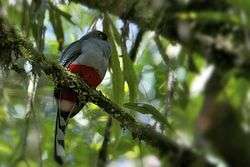Hispaniolan trogon
The Hispaniolan trogon (Priotelus roseigaster) is a species of bird in the family Trogonidae. It is the national bird of Haiti.[2] It is endemic to Hispaniola (Haiti and Dominican Republic) in the Caribbean. It is one of the only two trogon species found in the Caribbean.[3] Its natural habitats are subtropical or tropical moist montane forests, and heavily degraded forest. It is threatened by habitat loss. It is mostly confined to a few remaining protected areas.[4]
| Hispaniolan trogon | |
|---|---|
_(8082799519).jpg) | |
| At Sierra de Bahoruco National Park, Dominican Republic | |
| Scientific classification | |
| Kingdom: | Animalia |
| Phylum: | Chordata |
| Class: | Aves |
| Order: | Trogoniformes |
| Family: | Trogonidae |
| Genus: | Priotelus |
| Species: | P. roseigaster |
| Binomial name | |
| Priotelus roseigaster (Vieillot, 1817) | |
| Synonyms | |
|
Temnotrogon roseigaster | |
Identification

Trogons are brightly coloured birds with long, strongly graduated tails, small feet, and short, thick bills. The Hispaniolan trogon has metallic green upperparts, a gray throat and breast, and a red belly and is separated from the closely related Cuban trogon by the more typical tail of this species. The underside of the tail is dark, but each rectrix is broadly tipped with white. Males and females look similar but the females' wing coverts and secondaries lack the narrow white bars. The male average measurements for wing, tail, culem from base and tarsus are 135.2, 154, 17.3, 16.8 mm respectively. The female averages are 136.6, 154, 16.5, 16.4 mm[3]
Vocalizations
The song is rather slow and can be heard from quite a distance. It has a low rattle.[5]
Habitat
It inhabits rain, dry, pine and broadleaved deciduous forests. Several early records included mangrove swamps west of Miragoane [5] but whether these were visitors or a resident population is unknown. It requires large, old decayed trees with holes for nesting.[6] It primarily occurs at 500–3,000 m, but there appears to be some altitudinal migration with birds observed at lower elevations in winter. In Haiti, it is restricted to the Massif de la Hotte and Chaîne de la Selle, due to extensive habitat loss. It is still quite common in the Dominican Republic, especially in the relatively undisturbed Sierra de Baoruco, although there has been a moderately rapid population reduction, owing to deforestation.[6]
Diet
It is known to mainly eat insects, though it also takes small vertebrates such as anoles and fruits, especially those of the West Indian sumac (Brunellia comocladifolia).[3]
Behaviour
Its foraging behaviour is presumed to be similar to that of other species of trogon: most food is taken in aerial sallies to fruit or to surrounding vegetation. The species primarily forages in the midstory of humid deciduous and pine forests. A study of mixed-species flocks on Hispaniola recorded two encounters with the Hispaniolan trogon, both of which were associated with mixed flocks.[3]
Reproduction
The Hispaniolan trogon's breeding season is thought to be March to July. The nest is a cavity in a tree, including cavities of the Hispaniolan woodpecker (Melanerpes striatus).[3] The only known clutches are of two eggs; eggs are pale green and unmarked. Egg measurements [5] ranged from 27.9 by 23.5 mm to 31.4 by 23.9 mm. The lengths of the incubation period and nestling periods are unknown.[3] Generation length is estimated at 7.3 years[4]
Population and conservation
The Hispaniolan trogon is a forest-dependent species, and is vulnerable to habitat loss or degradation [3] The IUCN Red List conservation status of the Hispaniolan trogon is assessed as Near Threatened, because its population is continuing to decline throughout its small range, owing to forest degradation and fragmentation.[4] Forest loss and fragmentation owing to shifting agriculture are causing a decline, particularly in moist forest areas. Dry forests have been considerably altered by charcoal production, and pine forests have been reduced as a consequence of indiscriminate logging and clear-cutting. In particular, recent habitat destruction along highways has caused a drastic decline of the population in the Cordillera Central, but it is occasionally seen on abandoned coffee farms and old cocoa groves in the Cordillera Septentrional. The species is also subject to hunting.[6] However, as the range is relatively wide and not yet severely fragmented, the species is classified as Near Threatened.[4]
Some populations are afforded protection by national parks, such as in the Sierra de Baoruco. Proposed conservation actions include:[6]
1 - monitoring the population regularly.
2 - effectively protect national parks holding populations of this species.
3 - encourage forms of agriculture which do not require forest clearance.
4 - discourage charcoal production in native forests.
5 - raise awareness of the uniqueness of the species and discourage hunting.
References
- BirdLife International (2018). "Priotelus roseigaster". IUCN Red List of Threatened Species. 2018. Retrieved 17 December 2018.CS1 maint: ref=harv (link)
- CIA World Factbook: National Symbols
- Gerbracht, Jeff. 2011. Hispaniolan Trogon (Priotelus roseigaster), Neotropical Birds Online (T. S. Schulenberg, Editor). Ithaca: Cornell Lab of Ornithology; retrieved from Neotropical Birds Online: http://neotropical.birds.cornell.edu/portal/species/overview?p_p_spp=26030
- BirdLife International. 2012. Temnotrogon roseigaster. The IUCN Red List of Threatened Species 2012: e.T22682751A40520814. doi:10.2305/IUCN.UK.2012-1.RLTS.T22682751A40520814.en. Downloaded on 24 April 2016
- Wetmore, A., and B. H. Swales. 1931. The birds of Haiti and the Dominican Republic. United States National Museum Bulletin 155.
- BirdLife International (2016) Species factsheet: Temnotrogon roseigaster. Downloaded from http://www.birdlife.org on 24/04/2016.
- American Ornithologists' Union. Check-list of North American Birds - Trogoniformes. Accessed on April 17, 2009.
